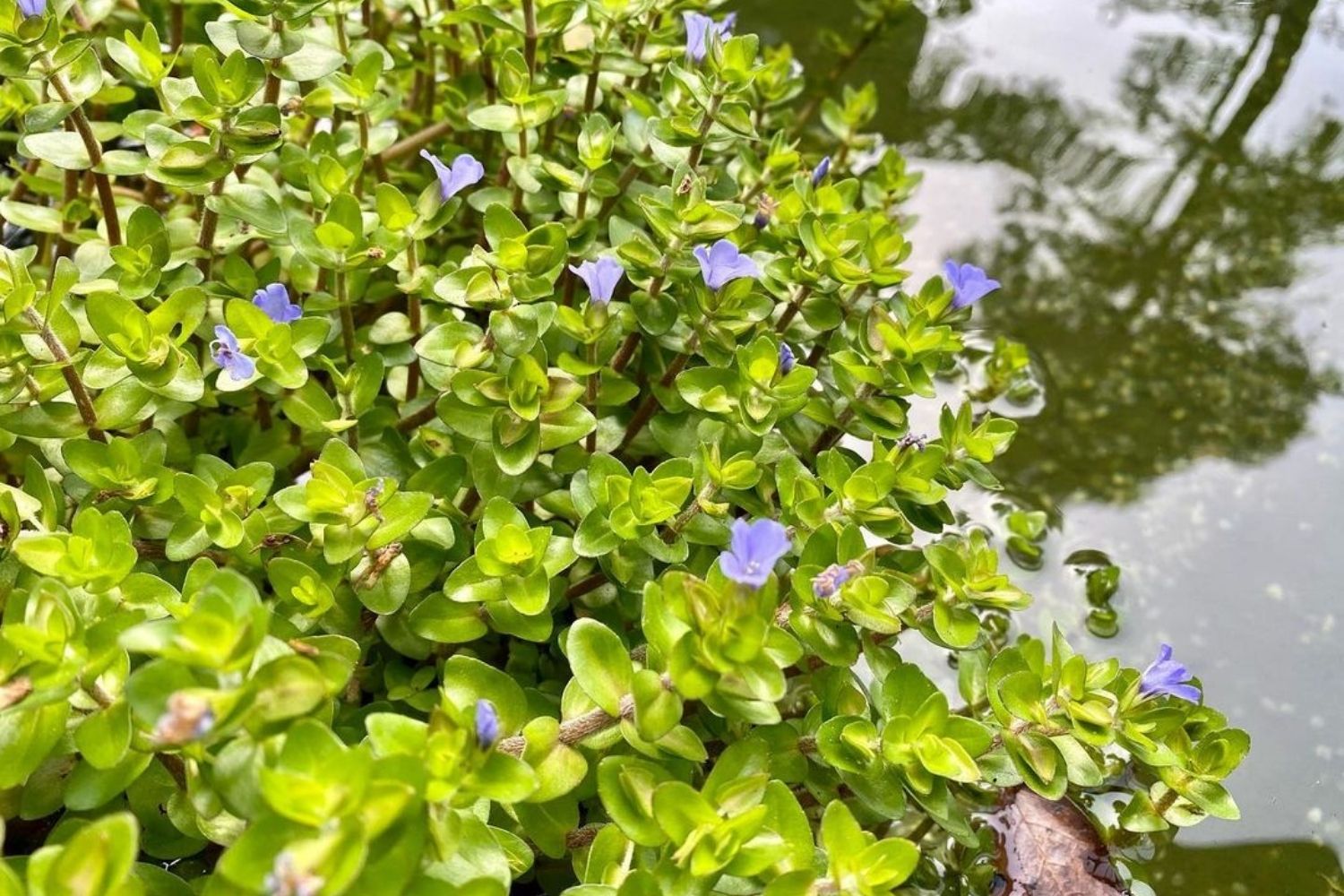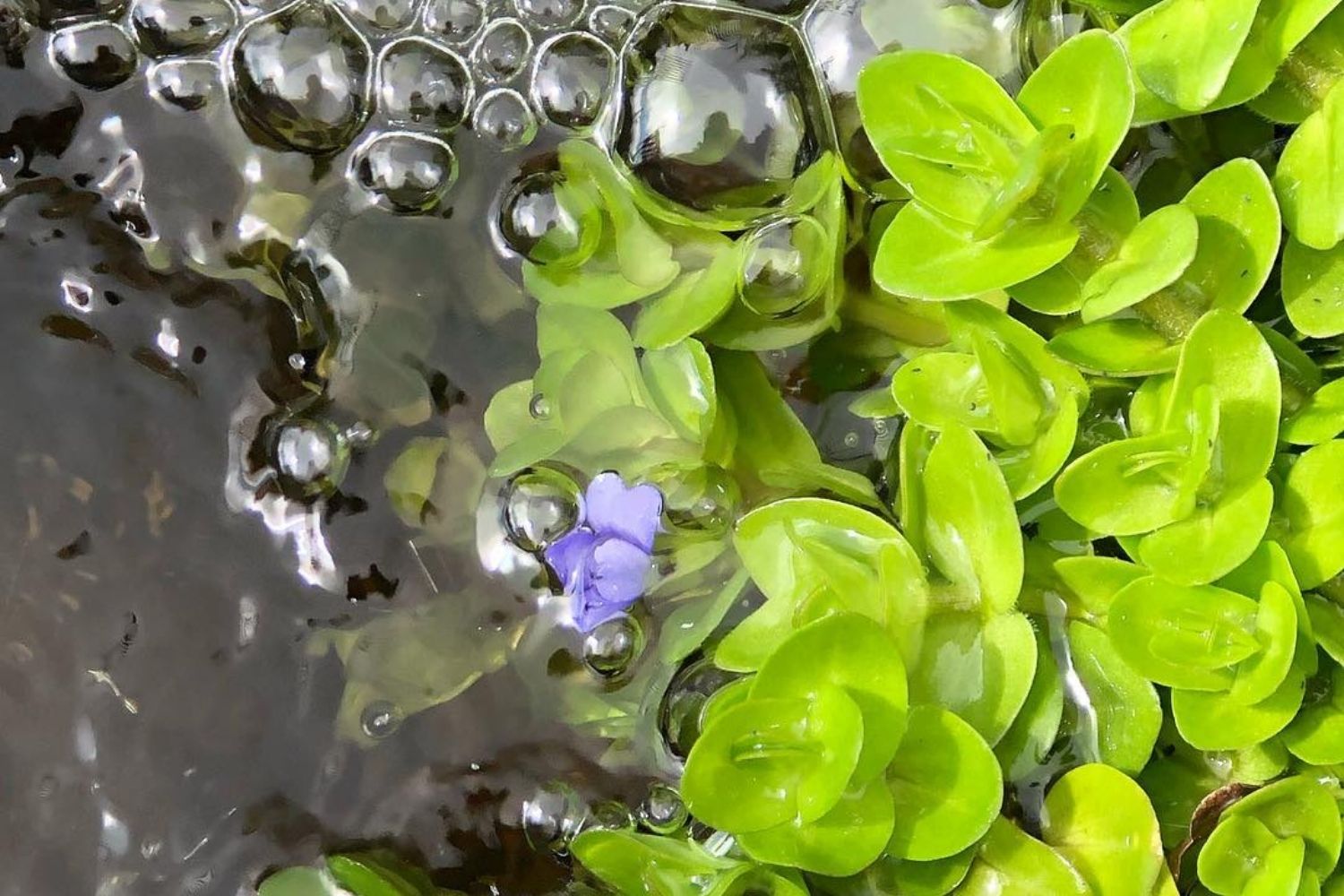Bacopa Caroliniana is a very popular freshwater aquarium plant, part of the Plantaginaceae family. Bacopa Caroliniana is the scientific name; occasionally, it is called Water Hyssop, Giant Red Bacopa, or Lemon Bacopa. The last-mentioned name comes because the leaves smell like lemon.
A grown Bacopa Caroliniana is quite tall. It is normally placed at the back of a tank where it can’t block the view. Also, it’s a great way to hide the equipment of the aquarium.
| Care difficulty | Easy |
| Lightning | Moderate |
| CO2 | Not needed - to low |
| Growth rate | Moderate |
| Growth form | Stem |
| Temperature | 20 – 28 °C (68 – 82 °F) |
| pH | 6.0 – 8.0 |
| dH | Soft to hard |
| Placement in tank | Background |
| Substrate | Any |
| Size | 20 to 40+ cm (8 – 16 inches or more) |
| Fertilizers | Not needed to low |
| Propagation | By cutting |
Origin & Habitat
Bacopa Caroliniana is a native plant that belongs to North America. This plant is a species of the genus Bacopa, and this species has around 70 to 100 different aquatic plants that belong to the Scrophulariaceae family. Let me describe for you the taxonomic hierarchy of this wonderful plant, Bacopa Caroliniana.
- Clade: Tracheophytes or Vascular plants
- Family: Scrophulariaceae ( A unique family of flowering plants, which are also known as the figwort family)
- Genus: Bacopa ( a small bushy water plant, which is aromantic and a part of the mint family)
- Species: Bacopa Caroliniana
- Common names: blue water Hyssop, mint bacopa, and lemon bacopa
- Synonyms: Obolaria Caroliniana, Bacopa Amplexicaulis, Herpestes Caroliniana.

Natural habitat of Bacopa Caroliniana. Lakes in Florida.
This adorable plant is seen very often in Florida, and also it is distributed throughout the Southeastern United States. It is also seen in South Carolina, Alabama, Maryland, Texas, and other places, where there is a huge blue water hyssop population. Bacopa aquarium plant is a hydrophyte. It is found in marshes, lakes, wetlands, and ponds, where it grows as an emerging plant.
Benefits of Bacopa Caroliniana
This wonderful aquarium plant, Bacopa Caroliniana, has a lot of benefits, and I am going to mention some of them.
- Aquascape: The Bacopa Caroliniana plant is very tall. You can use it as a decoration for the background section of the aquarium. It has a tall bold structure and is bold tall, a very aesthetic plant with a uniformed leaf platform, which makes it a delight for the viewers.
- Foraging place: this plant serves as a food haunting ground for fish, snails, and shrimp. You can see them going around and inside the plant, searching for tiny food particles or detritus.
- Removal of excess nutrients: Lemon bacopa is also known for the utilization of the excess nutrients, as well as for cleaning the tank water.
- Shelter: Small fish and shrimp can use this plant as breeding to lay their eggs or as a cover to hide. It is a must-have plant for a shrimp tank.
- Oxygenation: Oxygenates the water column and creates the pearling phenomena.
Pearling phenomena created by oxygen release from Bacopa Caroliniana plant.
- Reduces algal bloom: Helps to reduce the possibility of algal bloom in the environment.
- Source of Food: These two plants, Bacopa Caroliniana and Bacopa Monnieri, are edible and can be used to make salads.
How to Plant and Trim It?
The Bacopa Caroliniana plant can be cultivated by placing healthy specimens with pancetta, always being careful not to break the fragile stems during this procedure. In the beginning, these plants will appreciate the addition of fertilizers, which promotes healthy and overall development.

Bacopa Caroliniana can be used to create a natural background on your tank.
To trim it, this plant should be cut horizontally in order to limit its growth. It can get very long, that’s why we should trim it. In this case, we should be careful not to damage it, and cut the extended parts of the plant, not from the roots.
Care and Tank Requirements
If you are careful with it by maintaining the appropriate water parameters and the nutritional requirements are adequately met, the Bacopa Caroliniana plant will reward you with healthy growth.
Tank Size and Substrate
This plant can thrive in a variety of tank sizes (even for small sizes if it’s properly maintained). Although, because of the large size and mass of this plant species, the minimum tank to grow Bacopa Caroliniana is 40L (10 gallons), it is a pretty tall plant.
This plant does not require a nutrient-rich substrate. Even if it will benefit the plant. This plant can grow even in the gravel but also in sand. As long as your snail and your fish will produce enough waste, you won’t need to add fertilizers.

Bacopa Caroliniana can be kept and plant on pond and freshwater aquariums.
Water Parameters
The optimal temperature to grow Bacopa Caroliniana is between 20-28°C, which is 68 – 82 F. The plant is as well tolerant of cooler temperatures but not less than 13 °C. It is recommended that the pH for this plant be 6.0-8.0, which is the best for it. Bacopa Caroliniana can tolerate hard and soft water. It can thrive best in water hardness between 2-15 GH.
Lighting, CO2, and Fertilization
Bacopa Caroliniana can grow in fairly low to high light levels. That’s the main reason why it is one of the best plants for low-light tanks. I think that this is the best plant because it is very adaptive. But strong lightning will help the plant to provide the best growth.
If the plant has low light, it will grow just green, and if it has bright light, the top leaves will turn reddish. But if you want to help this plant, you should maintain a photoperiod of 8-10 hours on a daily basis.
Bacopa Caroliniana will grow even without CO2 injection. Fertilizer implementation depends on the tank system. If your substrate is rich in minerals or if there is a lot of shrimp, fish, and snail waste in the tank, it will be enough.
Tip: Usually, stem plants feed on the water column. That is why if you use one, you should measure liquid fertilizers.
However, in other cases, the plant may not grow healthy in tanks without fertilizer application. So, that’s why you will have to add some from time to time for overall good health. Potassium and iron supplements will help the plant maintain its appealing green coloration and its healthy structure.
Propagation
The propagating procedure of the Bacopa Caroliniana is easy, the sideways shots can be cut off and replanted in the substrate. These cuttings should be 7-15cm long (3-6 inches). From the lower 2 inches, you should remove the leaves at the bottom of the stem and place it into the substrate.

A closer look at Bacopa aquarium plant.
The side shots that you will clip of the plant, you can replant them, and they will root after some days to form new plants. But remember, don’t plant the stems too close to each other because overcrowding can cause competition for nutrients, which affects the plant’s health.
Note: You can also leave the Bacopa Caroliniana float after cutting until they develop roots.
Common Problems
Here are some common problems of Bacopa Caroliniana.
- Melting: If there is poor water quality, or when the plant grows out of the water without acclimation, then you might see Bacopa Caroliniana melting in the tank. You only have to get rid of the dying parts, then make sure that the plant will have good condition, and also add fertilizers to give a boost for the plant to grow healthy.
- Algae: This comes as a result of infected plants and aquarium materials. Including the poor water quality and intemperate lighting quality, which can trigger the growth of algae. This can be reduced by fixing the water quality, reducing the light severity and photoperiod, also by disinfecting the plants, and arranging materials before placing them in the tank.
- Difficulty in staying rooted: Another usual problem is the incapacity of the plant’s stems to stand set in the substrate without floating up.
- Loss of lower leaves: The base of Bacopa Caroliniana often starts to look irritated because the leaves get bigger and bigger and block the light. If you notice this, I recommend cutting the top and replanting them. This way also, the plant will have enough light.
Bacopa Monnieri or Bacopa Caroliniana?
Bacopa Monnieri has more node spacing and circular leaves. Bacopa Caroliniana has heavy, thick nodes and pointed leaves with red shades when they are on top. Monnieri grows a beautiful flower outside the water.
- Bacopa Caroliniana: larger, sharp leaves; leaves at the top will turn reddish; nodes are closer to each other.
- Bacopa Monnieri: smaller, circular leaves; usually green leaves; nodes are spaced a bit further from each other. The Bacopa Caroliniana is darker.

Bacopa Caroliniana has a purple flowers, different from the white flowers of Bacopa Monnieri
The Bacopa Caroliniana has a more pointed exterior end and has a larger leaf, but it is not pointer through the surface. Bacopa Monnieri is a more consistent “green” color.
Ideal Tank Mates
Bacopa Caroliniana can also be introduced in any kind of tank with freshwater. And you won’t have to worry if the fish will eat it, because the chances that they will eat the plant are very low, but even if they attempt to eat it, the plant can survive their attacks, but if they tend to eat it, they won’t, because the plant has an unpleasant scent for the fish.
If you prefer to play safe, you can choose shrimp, snails, and livebearers. Some good examples of their ideal tank mates:
- Peaceful Fish. It is a very good idea to add some friends to this plant, in the company of fish that won’t harm it. Also including Panda Loach, Black Moor Goldfish, Neon Tetras, Odessa Barb, Green Swordtails, Panda Garra, blue wagtail platy, etc.
- Shrimp. Shrimp species, including all varieties of Neocaridina species. You can keep any shrimp species with this wonderful plant.
- Snails (like, for example, Nerite snails, Ramshorn snails, Malaysian Trumpet snails, Mystery snails, and Japanese trapdoor snails). You have to be careful because snails tend to harm plants.
But also I want to mention another important thing that would look amazing. You should add the Subwassertang plant because this way it will be a wonderful combo if you keep them together. That’s how we keep it in our tank.
Avoid: I recommend you not keep Bacopa Caroliniana with crabs or crayfish. Even if they don’t eat Bacopa Carolinians, they will cut or uproot the plant. However, the best choice is to have floater plants in their own tanks.
Conclusion: Is This Plant Right For Your Tank?
The Bacopa Caroliniana plant is easy to grow. It does not require too much care, which makes it an easy and more practical choice for beginners. Also, the Lemon Bacopa can survive with varying temperature degrees of the water and also hardness conditions. Bacopa Caroliniana creates a strong upright accent in the background of the tank with its strong stems, and this is only of the countless benefits that this plant has.

We keep Bacopa Caroliniana with a lot of other aquarium plants.
This plant will enchant your tank with its purple flower blossom when emersed, and when leaves at the top of the water will turn reddish. These unique characteristics make the Bacopa aquarium plant a potential aqua plant for aquarium enthusiasts.


